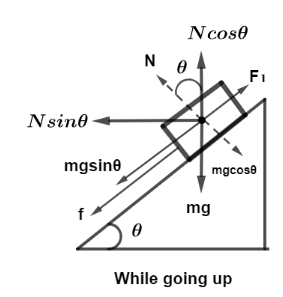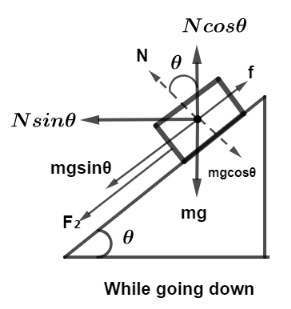
Answer
372.3k+ views
Hint: In order to solve this question we need to understand friction and Newton's second law of motion. Friction is an opposing force which always acts against the motion of the body and this force is directly proportional to normal on the body where coefficient of friction is proportionality constant. There are two types of friction one is static friction and other is kinetic friction, static friction acts on the body when the body is kept at rest while the kinetic friction acts on the body when the body is moving. So to move the body we just have to apply force which is equal or greater than friction.
Complete step by step answer:
Coefficient of friction is $\mu = 0.25$. Let the angle inclination of the plane be $\theta $. So while moving up the inclined plane, from the figure

The normal is $N = mg\cos \theta $.
So the frictional force acts in downward direction along inclined plane is,
$f = \mu N$
$\Rightarrow f = \mu mg\cos \theta $
Also the component of gravity force in downward direction along inclined planes is $mg\sin \theta $. So total force that needed just to move up the inclined plane is given by,
$F = mg\sin \theta + f$
Putting values we get, $F = mg\sin \theta + \mu mg\cos \theta $
While moving down the inclined plane,

The normal is $N = mg\cos \theta $.
So the frictional force acts in upward direction along inclined plane is, $f = \mu N$
$f = \mu mg\cos \theta $
Also the component of gravity force in downward direction along inclined planes is $mg\sin \theta $.So total force that needed just to move up the inclined plane is given by,
${F_1} = mg\sin \theta - f$
Putting values we get,
${F_1} = mg\sin \theta - \mu mg\cos \theta $
So according to question,
$F = 2{F_1}$
Putting values we get,
$mg\sin \theta + \mu mg\cos \theta = 2(mg\sin \theta - \mu mg\cos \theta )$
$\Rightarrow 3\mu mg\cos \theta = mg\sin \theta $
$\Rightarrow 3\mu = \tan \theta $
$\Rightarrow \theta = {\tan ^{ - 1}}(3 \times 0.25)$
$\Rightarrow \theta = {\tan ^{ - 1}}(0.75)$
$\therefore \theta = 36.86^\circ $
So the correct option is A.
Note: It should be remembered that both the forces either frictional or downward component of gravitational force produce torque but in opposite direction and equal in magnitude so net torque is zero and that’s why body only translates rather than it rotates.There are four fundamental forces in nature.
Complete step by step answer:
Coefficient of friction is $\mu = 0.25$. Let the angle inclination of the plane be $\theta $. So while moving up the inclined plane, from the figure

The normal is $N = mg\cos \theta $.
So the frictional force acts in downward direction along inclined plane is,
$f = \mu N$
$\Rightarrow f = \mu mg\cos \theta $
Also the component of gravity force in downward direction along inclined planes is $mg\sin \theta $. So total force that needed just to move up the inclined plane is given by,
$F = mg\sin \theta + f$
Putting values we get, $F = mg\sin \theta + \mu mg\cos \theta $
While moving down the inclined plane,

The normal is $N = mg\cos \theta $.
So the frictional force acts in upward direction along inclined plane is, $f = \mu N$
$f = \mu mg\cos \theta $
Also the component of gravity force in downward direction along inclined planes is $mg\sin \theta $.So total force that needed just to move up the inclined plane is given by,
${F_1} = mg\sin \theta - f$
Putting values we get,
${F_1} = mg\sin \theta - \mu mg\cos \theta $
So according to question,
$F = 2{F_1}$
Putting values we get,
$mg\sin \theta + \mu mg\cos \theta = 2(mg\sin \theta - \mu mg\cos \theta )$
$\Rightarrow 3\mu mg\cos \theta = mg\sin \theta $
$\Rightarrow 3\mu = \tan \theta $
$\Rightarrow \theta = {\tan ^{ - 1}}(3 \times 0.25)$
$\Rightarrow \theta = {\tan ^{ - 1}}(0.75)$
$\therefore \theta = 36.86^\circ $
So the correct option is A.
Note: It should be remembered that both the forces either frictional or downward component of gravitational force produce torque but in opposite direction and equal in magnitude so net torque is zero and that’s why body only translates rather than it rotates.There are four fundamental forces in nature.
Recently Updated Pages
Who among the following was the religious guru of class 7 social science CBSE

what is the correct chronological order of the following class 10 social science CBSE

Which of the following was not the actual cause for class 10 social science CBSE

Which of the following statements is not correct A class 10 social science CBSE

Which of the following leaders was not present in the class 10 social science CBSE

Garampani Sanctuary is located at A Diphu Assam B Gangtok class 10 social science CBSE

Trending doubts
A rainbow has circular shape because A The earth is class 11 physics CBSE

Which are the Top 10 Largest Countries of the World?

Fill the blanks with the suitable prepositions 1 The class 9 english CBSE

How do you graph the function fx 4x class 9 maths CBSE

The Equation xxx + 2 is Satisfied when x is Equal to Class 10 Maths

Which is the first open university in India A Andhra class 10 physics CBSE

Difference between Prokaryotic cell and Eukaryotic class 11 biology CBSE

Give 10 examples for herbs , shrubs , climbers , creepers

Change the following sentences into negative and interrogative class 10 english CBSE




